Estimating Soil Organic Matter Content in Desert Areas Using In Situ Hyperspectral Data and Feature Variable Selection Algorithms in Southern Xinjiang, China
Abstract
1. Introduction
2. Materials and Methods
2.1. Study Area
2.2. Soil Sampling and SOM Measurement
2.3. In Situ Spectral Measurement and Pre-Processing
2.4. Feature Variable Selection Algorithms
2.5. Modeling Method
2.6. Model Accuracy Evaluation
3. Results
3.1. Descriptive Statistics for Soil Organic Matter (SOM) Content
3.2. Feature Variable Selected by PSO, ACO and SA algorithms
3.3. Estimation Accuracy for SOM with Different Models and Validation
4. Discussion
4.1. The Factors Affecting the Prediction of SOM with Vis-NIR In Situ Hyperspectral Data
4.2. The Effect of Feature Variable Selection Algorithms on Model Accuracy
4.3. Influence of the Different Modeling Methods on the SOM Prediction Accuracy
5. Conclusions
Author Contributions
Funding
Institutional Review Board Statement
Informed Consent Statement
Data Availability Statement
Conflicts of Interest
References
- De Santana, F.B.; de Giuseppe, L.O.; de Souza, A.M.; Poppi, R.J. Removing the moisture effect in soil organic matter determination using NIR spectroscopy and PLSR with external parameter orthogonalization. Microchem. J. 2019, 145, 1094–1101. [Google Scholar] [CrossRef]
- McBratney, A.; Field, D.J.; Koch, A. The dimensions of soil security. Geoderma 2014, 213, 203–213. [Google Scholar] [CrossRef]
- Lehmann, J.; Kleber, M. The contentious nature of soil organic matter. Nature 2015, 528, 60–68. [Google Scholar] [CrossRef] [PubMed]
- Muhammad, S.; Müller, T.; Joergensen, R.G. Decomposition of pea and maize straw in Pakistani soils along a gradient in salinity. Biol. Fert. Soils 2006, 43, 93–101. [Google Scholar] [CrossRef]
- Xu, S.; Zhao, Y.; Wang, M.; Shi, X. Comparison of multivariate methods for estimating selected soil properties from intact soil cores of paddy fields by Vis–NIR spectroscopy. Geoderma 2018, 310, 29–43. [Google Scholar] [CrossRef]
- Liu, Y.; Liu, Y.; Chen, Y.; Zhang, Y.; Shi, T.; Wang, J.; Hong, Y.; Fei, T.; Zhang, Y. The influence of spectral pretreatment on the selection of representative calibration samples for soil organic matter estimation using Vis-NIR reflectance spectroscopy. Remote Sens. 2019, 11, 450. [Google Scholar] [CrossRef]
- Bao, N.; Wu, L.; Ye, B.; Yang, K.; Zhou, W. Assessing soil organic matter of reclaimed soil from a large surface coal mine using a field spectroradiometer in laboratory. Geoderma 2017, 288, 47–55. [Google Scholar] [CrossRef]
- Rossel, R.V.; McBratney, A.B. Soil chemical analytical accuracy and costs: Implications from precision agriculture. Aust. J. Exp. Agric. 1998, 38, 765–775. [Google Scholar] [CrossRef]
- Jiang, Q.; Chen, Y.; Guo, L.; Fei, T.; Qi, K. Estimating soil organic carbon of cropland soil at different levels of soil moisture using VIS-NIR spectroscopy. Remote Sens. 2016, 8, 755. [Google Scholar] [CrossRef]
- Selige, T.; Böhner, J.; Schmidhalter, U. High resolution topsoil mapping using hyperspectral image and field data in multivariate regression modeling procedures. Geoderma 2006, 136, 235–244. [Google Scholar] [CrossRef]
- Nocita, M.; Kooistra, L.; Bachmann, M.; Müller, A.; Powell, M.; Weel, S. Predictions of soil surface and topsoil organic carbon content through the use of laboratory and field spectroscopy in the Albany Thicket Biome of Eastern Cape Province of South Africa. Geoderma 2011, 167, 295–302. [Google Scholar] [CrossRef]
- Swierenga, H.; De Groot, P.J.; De Weijer, A.P.; Derksen, M.W.J.; Buydens, L.M.C. Improvement of PLS model transferability by robust wavelength selection. Chemometr. Intell. Lab. Syst. 1998, 41, 237–248. [Google Scholar] [CrossRef]
- Swierenga, H.; Wülfert, F.; De Noord, O.E.; De Weijer, A.P.; Smilde, A.K.; Buydens, L.M.C. Development of robust calibration models in near infra-red spectrometric applications. Anal. Chim. Acta. 2000, 411, 121–135. [Google Scholar] [CrossRef]
- Galvão, R.K.H.; Araújo, M.C.U.; Silva, E.C.; José, G.E.; Soares, S.F.C.; Paiva, H.M. Cross-validation for the selection of spectral variables using the successive projections algorithm. J. Am. Chem. Soc. 2007, 18, 1580–1584. [Google Scholar] [CrossRef]
- Zou, X.; Zhao, J.; Povey, M.J.; Holmes, M.; Mao, H. Variables selection methods in near-infrared spectroscopy. Anal. Chim. Acta 2010, 667, 14–32. [Google Scholar]
- Shi, T.; Chen, Y.; Liu, H.; Wang, J.; Wu, G. Soil organic carbon content estimation with laboratory-based visible–near-infrared reflectance spectroscopy: Feature selection. Appl. Spectrosc. 2014, 68, 831–837. [Google Scholar] [CrossRef]
- Xu, S.; Zhao, Y.; Wang, M.; Shi, X. Determination of rice root density from Vis–NIR spectroscopy by support vector machine regression and spectral variable selection techniques. Catena 2017, 157, 12–23. [Google Scholar] [CrossRef]
- Xie, S.; Ding, F.; Chen, S.; Wang, X.; Li, Y.; Ma, K. Prediction of soil organic matter content based on characteristic band selection method. Spectrochim. Acta A Mol. Biomol. Spectrosc. 2022, 273, 120949. [Google Scholar] [CrossRef]
- Hong, Y.; Chen, Y.; Yu, L.; Liu, Y.; Liu, Y.; Zhang, Y.; Liu, Y.; Cheng, H. Combining fractional order derivative and spectral variable selection for organic matter estimation of homogeneous soil samples by VIS–NIR spectroscopy. Remote Sens. 2018, 10, 479. [Google Scholar] [CrossRef]
- Xie, S.; Li, Y.; Wang, X.; Liu, Z.; Ma, K.; Ding, L. Research on estimation models of the spectral characteristics of soil organic matter based on the soil particle size. Spectrochim. Acta A Mol. Biomol. Spectrosc. 2021, 260, 119963. [Google Scholar] [CrossRef]
- Sun, W.; Liu, S.; Zhang, X.; Li, Y. Estimation of soil organic matter content using selected spectral subset of hyperspectral data. Geoderma 2022, 409, 115653. [Google Scholar] [CrossRef]
- Bai, Z.; Xie, M.; Hu, B.; Luo, D.; Wan, C.; Peng, J.; Shi, Z. Estimation of Soil Organic Carbon Using Vis-NIR Spectral Data and Spectral Feature Bands Selection in Southern Xinjiang, China. Sensors 2022, 22, 6124. [Google Scholar] [CrossRef]
- Mahesh, S.; Jayas, D.S.; Paliwal, J.; White, N.D.G. Comparison of partial least squares regression (PLSR) and principal components regression (PCR) methods for protein and hardness predictions using the near-infrared (NIR) hyperspectral images of bulk samples of Canadian wheat. Food Bioprocess Technol. 2015, 8, 31–40. [Google Scholar] [CrossRef]
- Wold, S.; Ruhe, A.; Wold, H.; Dunn, W.J., III. The collinearity problem in linear regression. The partial least squares (PLS) approach to generalized inverses. SIAM. J. Sci Comput. 1984, 5, 735–743. [Google Scholar] [CrossRef]
- Wijewardane, N.K.; Ge, Y.; Morgan, C.L. Moisture insensitive prediction of soil properties from VNIR reflectance spectra based on external parameter orthogonalization. Geoderma 2016, 267, 92–101. [Google Scholar] [CrossRef]
- Cheng, H.; Wang, J.; Du, Y. Combining multivariate method and spectral variable selection for soil total nitrogen estimation by Vis–NIR spectroscopy. Arch. Agron. Soil Sci. 2021, 67, 1665–1678. [Google Scholar] [CrossRef]
- Liu, H.; Zhang, Y.; Zhang, B. Novel hyperspectral reflectance models for estimating black-soil organic matter in Northeast China. Environ. Monit. Assess. 2009, 154, 147–154. [Google Scholar] [CrossRef] [PubMed]
- Ng, W.; Minasny, B.; Montazerolghaem, M.; Padarian, J.; Ferguson, R.; Bailey, S.; McBratney, A.B. Convolutional neural network for simultaneous prediction of several soil properties using visible/near-infrared, mid-infrared, and their combined spectra. Geoderma 2019, 352, 251–267. [Google Scholar] [CrossRef]
- LeCun, Y.; Bengio, Y.; Hinton, G. Deep learning. Nature 2015, 521, 436–444. [Google Scholar] [CrossRef]
- Xu, Z.; Zhao, X.; Guo, X.; Guo, J. Deep learning application for predicting soil organic matter content by VIS-NIR spectroscopy. Comput. Intell. Neurosci. 2019, 2019, 3563761. [Google Scholar] [CrossRef]
- World Reference Base for Soil Resources. International Soil Classification System For naming Soils and Creating Legends for Soil Maps; Food and Agriculture Organization of the United Nations: Rome, Italy, 2014. [Google Scholar]
- Peng, J.; Biswas, A.; Jiang, Q.; Zhao, R.; Hu, J.; Hu, B.; Shi, Z. Estimating soil salinity from remote sensing and terrain data in southern Xinjiang Province, China. Geoderma 2019, 337, 1309–1319. [Google Scholar] [CrossRef]
- Liang, Z.; Chen, S.; Yang, Y.; Zhao, R.; Shi, Z.; Rossel, R.A.V. National digital soil map of organic matter in topsoil and its associated uncertainty in 1980’s China. Geoderma 2019, 335, 47–56. [Google Scholar] [CrossRef]
- Ji, W.; Li, S.; Chen, S.; Shi, Z.; Rossel, R.A.V.; Mouazen, A.M. Prediction of soil attributes using the Chinese soil spectral library and standardized spectra recorded at field conditions. Soil Tillage Res. 2016, 155, 492–500. [Google Scholar] [CrossRef]
- De Santis, R.; Montanari, R.; Vignali, G.; Bottani, E. An adapted ant colony optimization algorithm for the minimization of the travel distance of pickers in manual warehouses. Eur. J. Oper. Res. 2018, 267, 120–137. [Google Scholar] [CrossRef]
- Liu, J.; Ma, X.; Li, X.; Liu, M.; Shi, T.; Li, P. Random convergence analysis of particle swarm optimization algorithm with time-varying attractor. Swarm. Evol. 2021, 61, 100819. [Google Scholar] [CrossRef]
- Kirkpatrick, S.; Gelatt, C.D., Jr.; Vecchi, M.P. Optimization by simulated annealing. Science 1983, 220, 671–680. [Google Scholar] [CrossRef]
- Siarry, P.; Berthiau, G.; Durdin, F.; Haussy, J. Enhanced simulated annealing for globally minimizing functions of many-continuous variables. ACM Trans. Math. Softw. 1997, 23, 209–228. [Google Scholar] [CrossRef]
- Hörchner, U.; Kalivas, J.H. Further investigation on a comparative study of simulated annealing and genetic algorithm for wavelength selection. Anal. Chim. Acta 1995, 311, 1–13. [Google Scholar] [CrossRef]
- Araújo, S.R.; Wetterlind, J.; Dematte, J.A.M.; Stenberg, B. Improving the prediction performance of a large tropical vis-NIR spectroscopic soil library from Brazil by clustering into smaller subsets or use of data mining calibration techniques. Eur. J. Soil Sci. 2014, 65, 718–729. [Google Scholar] [CrossRef]
- Morellos, A.; Pantazi, X.E.; Moshou, D.; Alexandridis, T.; Whetton, R.; Tziotzios, G.; Wiebensohn, J.; Bill, R.; Mouazen, A.M. Machine learning based prediction of soil total nitrogen, organic carbon and moisture content by using VIS-NIR spectroscopy. Biosyst. Eng. 2016, 152, 104–116. [Google Scholar] [CrossRef]
- Wang, L.; Zeng, Y.; Chen, T. Back propagation neural network with adaptive differential evolution algorithm for time series forecasting. Expert Syst. Appl. 2015, 42, 855–863. [Google Scholar] [CrossRef]
- Kavzoglu, T.; Mather, P.M. The use of backpropagating artificial neural networks in land cover classification. Int. J. Remote Sens. 2003, 24, 4907–4938. [Google Scholar] [CrossRef]
- LeCun, Y.; Bottou, L.; Bengio, Y.; Haffner, P. Gradient-based learning applied to document recognition. Proc. IEEE 1998, 86, 2278–2324. [Google Scholar] [CrossRef]
- Qu, J.L.; Yu, L.; Yuan, T.; Tian, Y.; Gao, F. Adaptive fault diagnosis algorithm for rolling bearings based on one-dimensional convolutional neural network. Chin. J. Sci. Instrum. 2018, 39, 134–143. [Google Scholar]
- Gholizadeh, A.; Žižala, D.; Saberioon, M.; Borůvka, L. Soil organic carbon and texture retrieving and mapping using proximal, airborne and Sentinel-2 spectral imaging. Remote Sens. Environ. 2018, 218, 89–103. [Google Scholar] [CrossRef]
- Kennard, R.W.; Stone, L.A. Computer aided design of experiments. Technometrics 1969, 11, 137–148. [Google Scholar] [CrossRef]
- Viscarra Rossel, R.A.; Behrens, T.; Ben-Dor, E.; Brown, D.J.; Demattê, J.A.M.; Shepherd, K.D.; Shi, Z.; Stenberg, B.; Stevens, A.; Adamchuk, V. A global spectral library to characterize the world’s soil. Earth-Sci. Rev. 2016, 155, 198–230. [Google Scholar] [CrossRef]
- Bishop, J.L.; Lane, M.D.; Dyar, M.D.; Brown, A.J. Reflectance and emission spectroscopy study of four groups of phyllosilicates: Smectites, kaolinite-serpentines, chlorites and micas. Clay Miner. 2008, 43, 35–54. [Google Scholar] [CrossRef]
- Christy, C.D. Real-time measurement of soil attributes using on-the-go near infrared reflectance spectroscopy. Comp. Electron. Agric. 2008, 61, 10–19. [Google Scholar] [CrossRef]
- Rinnan, Å.; Van Den Berg, F.; Engelsen, S.B. Review of the most common pre-processing techniques for near-infrared spectra. Trends Anal. Chem. 2009, 28, 1201–1222. [Google Scholar] [CrossRef]
- Waiser, T.H.; Morgan, C.L.; Brown, D.J.; Hallmark, C.T. In situ characterization of soil clay content with visible near-infrared diffuse reflectance spectroscopy. Soil Sci. Soc. Am. J. 2007, 71, 389–396. [Google Scholar] [CrossRef]
- Hutengs, C.; Seidel, M.; Oertel, F.; Ludwig, B.; Vohland, M. In situ and laboratory soil spectroscopy with portable visible-to-near-infrared and mid-infrared instruments for the assessment of organic carbon in soils. Geoderma 2019, 355, 113900. [Google Scholar] [CrossRef]
- Wu, C.Y.; Jacobson, A.R.; Laba, M.; Baveye, P.C. Accounting for surface roughness effects in the near-infrared reflectance sensing of soils. Geoderma 2009, 152, 171–180. [Google Scholar] [CrossRef]
- Stevens, A.; van Wesemael, B.; Bartholomeus, H.; Rosillon, D.; Tychon, B.; Ben-Dor, E. Laboratory, field and airborne spectroscopy for monitoring organic carbon content in agricultural soils. Geoderma 2008, 144, 395–404. [Google Scholar] [CrossRef]
- Lao, C.; Chen, J.; Zhang, Z.; Chen, Y.; Ma, Y.; Chen, H.; Ma, Y.; Chen, H.; Gu, X.; Ning, J.; et al. Predicting the contents of soil salt and major water-soluble ions with fractional-order derivative spectral indices and variable selection. Comp. Electron. Agric. 2021, 182, 106031. [Google Scholar] [CrossRef]
- Li, H.; Liang, Y.; Xu, Q.; Cao, D. Key wavelengths screening using competitive adaptive reweighted sampling method for multivariate calibration. Anal. Chim. Acta 2009, 648, 77–84. [Google Scholar] [CrossRef]
- Wu, Y.; Chen, J.; Ji, J.; Gong, P.; Liao, Q.; Tian, Q.; Ma, H. A mechanism study of reflectance spectroscopy for investigating heavy metals in soils. Soil Sci. Soc. Am. J. 2007, 71, 918–926. [Google Scholar] [CrossRef]
- Li, L.; Zhang, Y.; Fung, J.C.; Qu, H.; Lau, A.K. A coupled computational fluid dynamics and back-propagation neural network-based particle swarm optimizer algorithm for predicting and optimizing indoor air quality. Build. Environ. 2022, 207, 108533. [Google Scholar] [CrossRef]
- Chen, Y.; Wang, J.; Liu, G.; Yang, Y.; Liu, Z.; Deng, H. Hyperspectral estimation model of forest soil organic matter in northwest Yunnan Province, China. Forests 2019, 10, 217. [Google Scholar] [CrossRef]
- Khosravi, V.; Ardejani, F.D.; Yousefi, S.; Aryafar, A. Monitoring soil lead and zinc contents via combination of spectroscopy with extreme learning machine and other data mining methods. Geoderma 2018, 318, 29–41. [Google Scholar] [CrossRef]
- Liu, F.; Jiang, Y.; He, Y. Variable selection in visible-near infrared spectra for linear and nonlinear calibrations: A case study to determine soluble solids content of beer. Anal. Chim. Acta 2009, 635, 45–52. [Google Scholar] [CrossRef] [PubMed]
- Yuan, Q.; Shen, H.; Li, T.; Li, Z.; Li, S.; Jiang, Y.; Xu, H.; Tan, W.; Yang, Q.; Wang, J.; et al. Deep learning in environmental remote sensing: Achievements and challenges. Remote. Sens. Environ. 2020, 241, 111716. [Google Scholar] [CrossRef]
- Zhang, M.; Zhao, Z. Near Infrared Spectral Analysis Modeling Method Based on Deep Belief Network. Spectrosc. Spect. Anal. 2020, 40, 2512. [Google Scholar]
- Zhang, Z.; Ding, J.; Zhu, C.; Wang, J.; Ma, G.; Ge, X.; Li, Z.; Han, L. Strategies for the efficient estimation of soil organic matter in salt-affected soils through Vis-NIR spectroscopy: Optimal band combination algorithm and spectral degradation. Geoderma 2021, 382, 114729. [Google Scholar] [CrossRef]
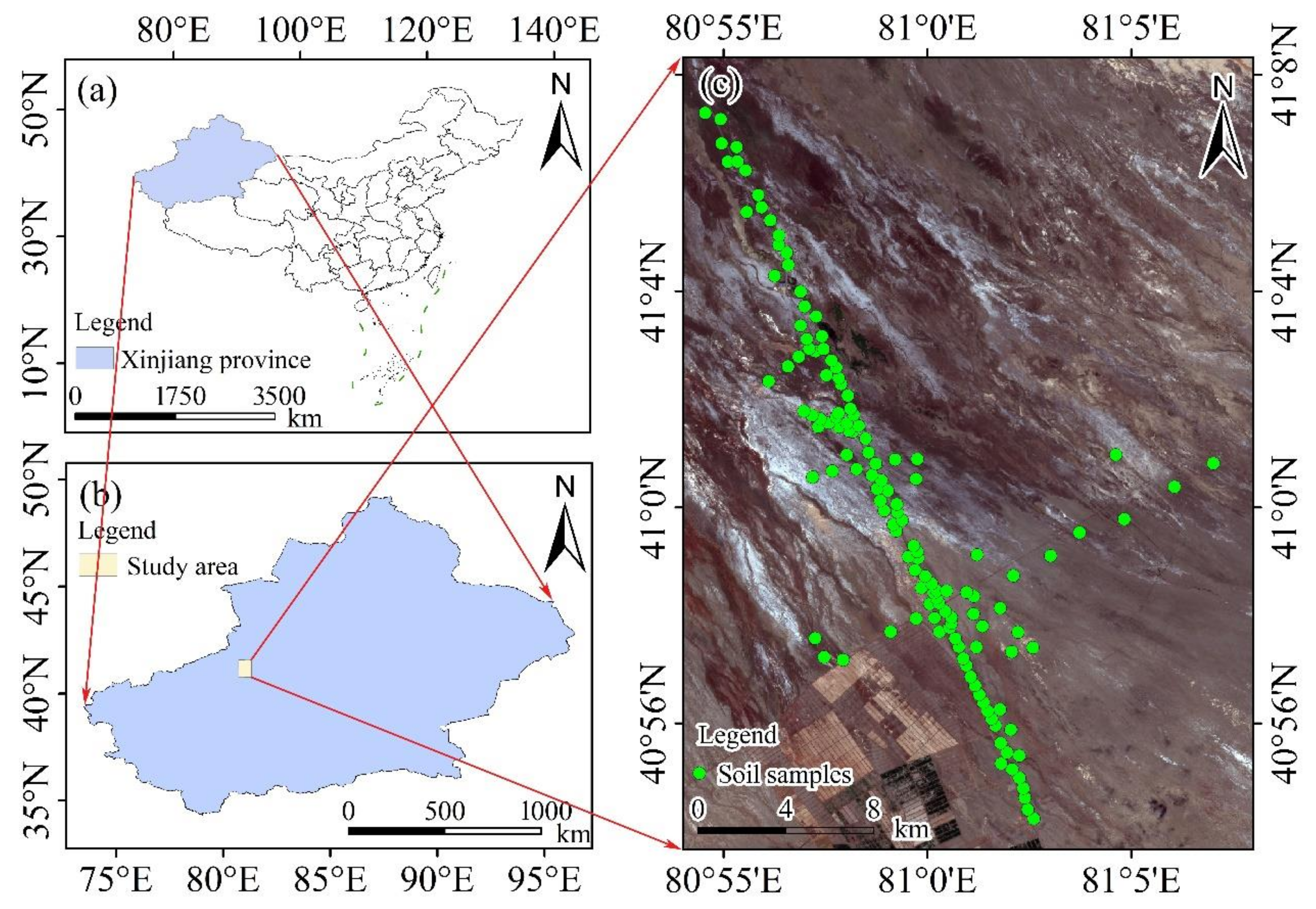
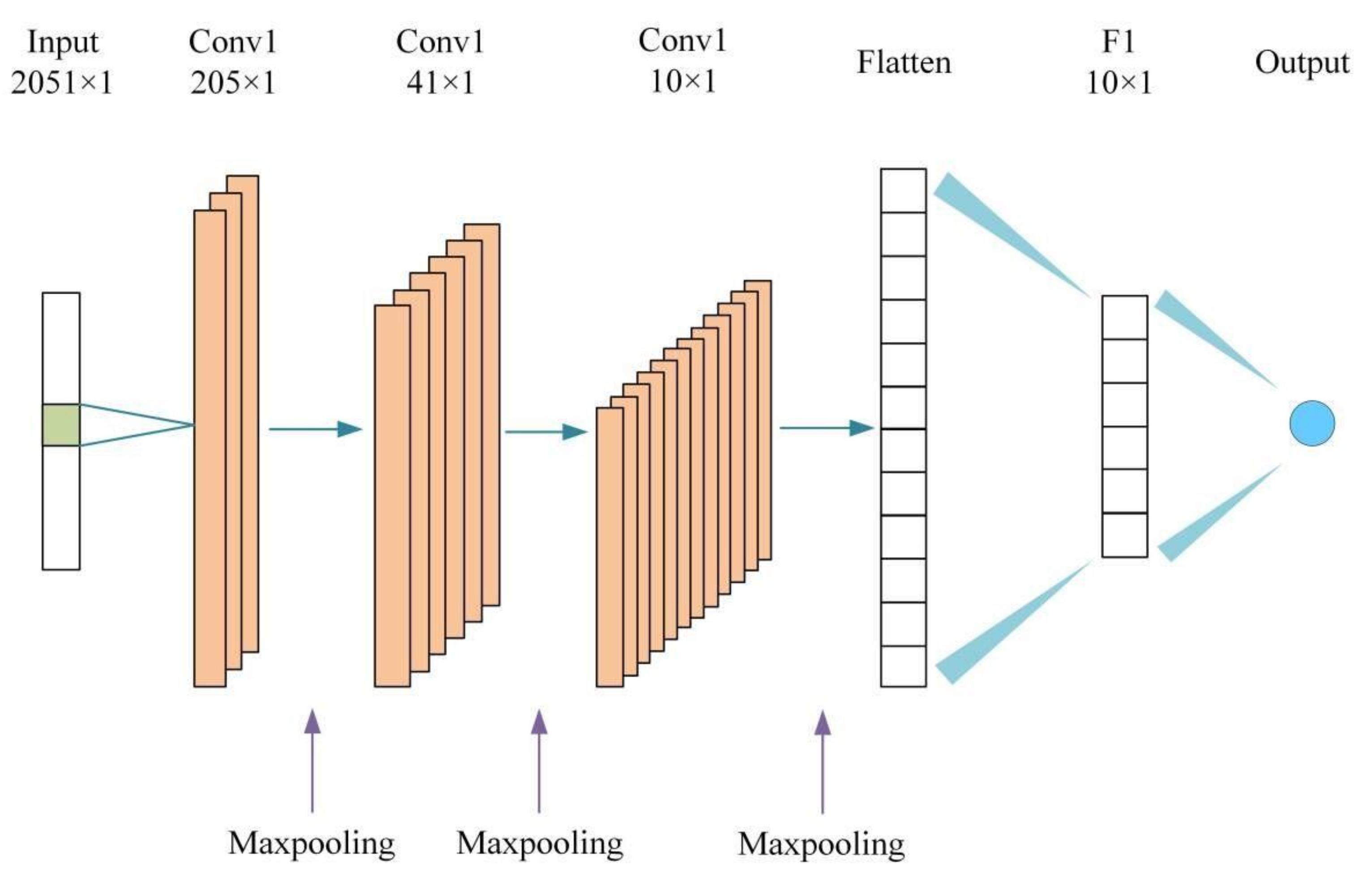
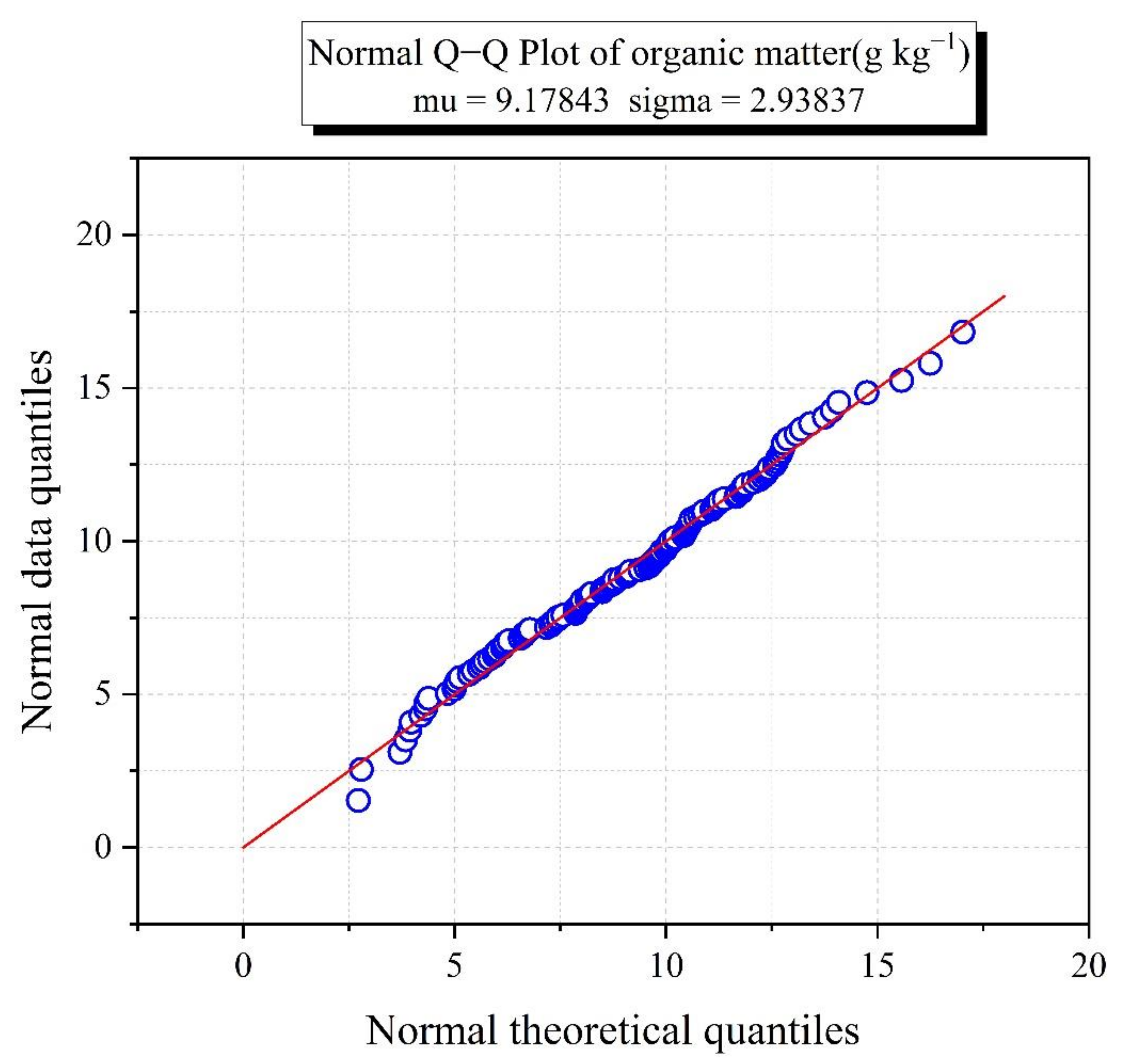
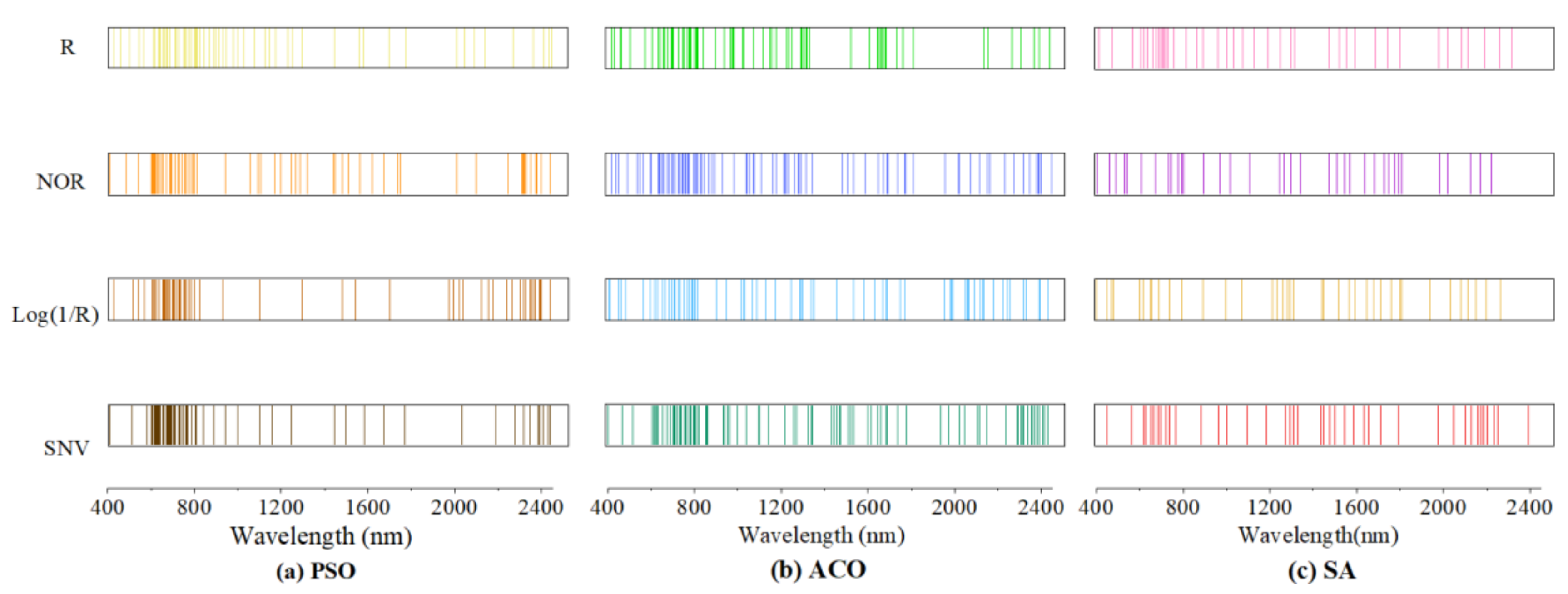
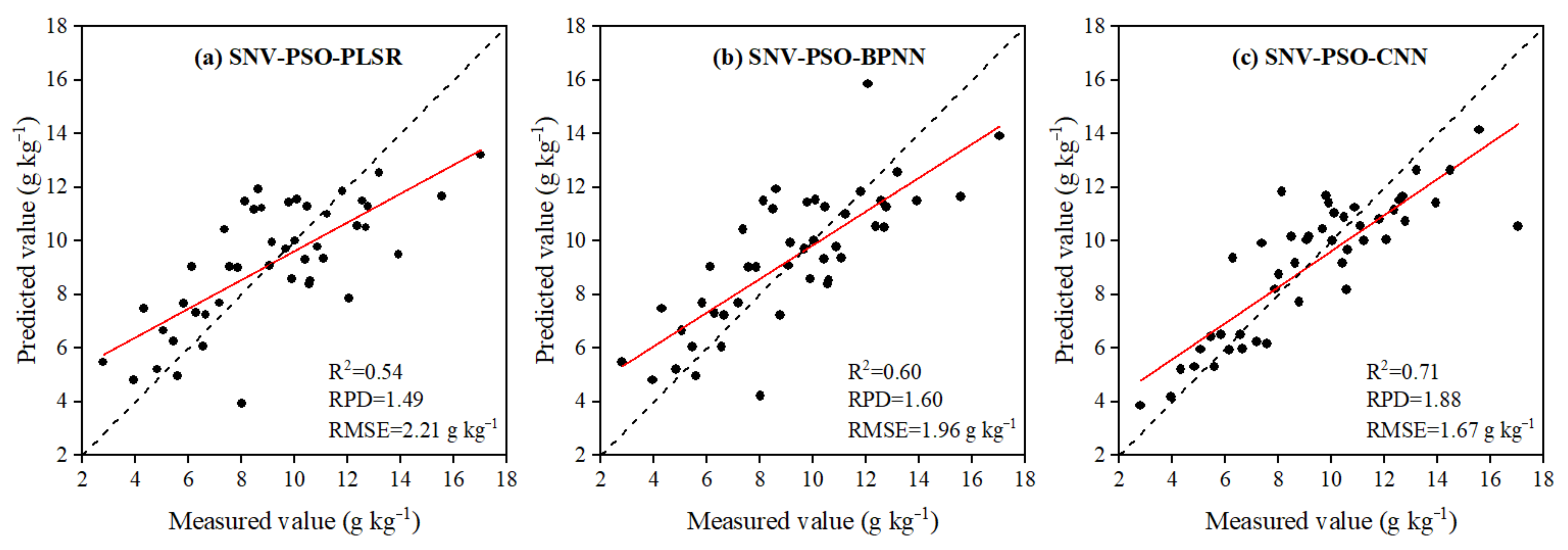
| Hyperparameter | Values |
|---|---|
| Kernel size 1 | 10 |
| Kernel size 2 | 5 |
| Kernel size 3 | 4 |
| Batch size | 11 |
| Dropout layer | 0.5 |
| Max. epochs | 1000 |
| Learning rate | 0.00005 |
| Learning rate decay | 0.001 |
| Dataset | Number | Mean | Min a | Max b | SD c | CV d (%) |
|---|---|---|---|---|---|---|
| Calibration | 90 | 9.38 | 2.72 | 18.18 | 3.09 | 32.94 |
| Validation | 45 | 9.36 | 2.80 | 17.02 | 3.08 | 32.91 |
| Total | 135 | 9.37 | 2.72 | 18.18 | 3.08 | 32.87 |
| Model | Spectral Pretreatments | Variable Number | Calibration | Validation | |||
|---|---|---|---|---|---|---|---|
| R2 | RMSE | R2 | RMSE | RPD | |||
| PLSR | R | 2051 | 0.35 | 2.51 | 0.34 | 2.54 | 1.24 |
| SNV | 2051 | 0.45 | 2.35 | 0.42 | 2.46 | 1.28 | |
| Log(1/R) | 2051 | 0.42 | 2.41 | 0.40 | 2.49 | 1.26 | |
| NOR | 2051 | 0.38 | 2.44 | 0.37 | 2.53 | 1.24 | |
| R-PSO | 63 | 0.53 | 2.21 | 0.51 | 2.19 | 1.41 | |
| SNV-PSO | 64 | 0.59 | 1.81 | 0.54 | 2.12 | 1.49 | |
| Log(1/R)-PSO | 63 | 0.52 | 2.15 | 0.53 | 2.14 | 1.43 | |
| NOR-PSO | 65 | 0.50 | 2.25 | 0.48 | 2.21 | 1.40 | |
| R-ACO | 71 | 0.45 | 2.46 | 0.43 | 2.50 | 1.27 | |
| SNV-ACO | 92 | 0.48 | 2.39 | 0.49 | 2.30 | 1.35 | |
| Log(1/R)-ACO | 75 | 0.47 | 2.41 | 0.45 | 2.47 | 1.30 | |
| NOR-ACO | 93 | 0.49 | 2.31 | 0.47 | 2.40 | 1.31 | |
| R-SA | 41 | 0.44 | 2.45 | 0.43 | 2.40 | 1.31 | |
| SNV-SA | 42 | 0.46 | 2.37 | 0.45 | 2.38 | 1.32 | |
| Log(1/R)-SA | 38 | 0.44 | 2.46 | 0.41 | 2.48 | 1.29 | |
| NOR-SA | 36 | 0.43 | 2.48 | 0.42 | 2.43 | 1.30 | |
| BPNN | R | 2051 | 0.37 | 2.40 | 0.36 | 2.53 | 1.25 |
| SNV | 2051 | 0.48 | 2.00 | 0.45 | 2.42 | 1.29 | |
| Log(1/R) | 2051 | 0.44 | 2.12 | 0.43 | 2.47 | 1.28 | |
| NOR | 2051 | 0.41 | 2.25 | 0.39 | 2.48 | 1.27 | |
| R-PSO | 63 | 0.58 | 1.83 | 0.56 | 2.17 | 1.45 | |
| SNV-PSO | 64 | 0.62 | 1.74 | 0.60 | 1.96 | 1.60 | |
| Log(1/R)-PSO | 63 | 0.59 | 1.82 | 0.57 | 2.10 | 1.50 | |
| NOR-PSO | 65 | 0.55 | 1.95 | 0.54 | 2.19 | 1.43 | |
| R-ACO | 71 | 0.51 | 2.00 | 0.47 | 2.42 | 1.30 | |
| SNV-ACO | 92 | 0.54 | 1.94 | 0.55 | 2.20 | 1.43 | |
| Log(1/R)-ACO | 75 | 0.53 | 1.96 | 0.50 | 2.29 | 1.36 | |
| NOR-ACO | 93 | 0.55 | 1.92 | 0.52 | 2.25 | 1.40 | |
| R-SA | 41 | 0.47 | 2.11 | 0.45 | 2.39 | 1.32 | |
| SNV-SA | 42 | 0.49 | 2.01 | 0.47 | 2.38 | 1.33 | |
| Log(1/R)-SA | 38 | 0.45 | 2.13 | 0.43 | 2.41 | 1.30 | |
| NOR-SA | 36 | 0.44 | 2.23 | 0.44 | 2.40 | 1.31 | |
| CNN | R | 2051 | 0.39 | 2.44 | 0.38 | 2.52 | 1.27 |
| SNV | 2051 | 0.47 | 1.87 | 0.46 | 2.39 | 1.32 | |
| Log(1/R) | 2051 | 0.46 | 1.89 | 0.44 | 2.42 | 1.30 | |
| NOR | 2051 | 0.44 | 1.92 | 0.42 | 2.48 | 1.27 | |
| R-PSO | 63 | 0.65 | 1.65 | 0.64 | 1.87 | 1.69 | |
| SNV-PSO | 64 | 0.73 | 1.51 | 0.71 | 1.67 | 1.88 | |
| Log(1/R)-PSO | 63 | 0.68 | 1.64 | 0.66 | 1.84 | 1.71 | |
| NOR-PSO | 65 | 0.63 | 1.69 | 0.62 | 1.94 | 1.63 | |
| R-ACO | 71 | 0.55 | 1.86 | 0.54 | 2.20 | 1.45 | |
| SNV-ACO | 92 | 0.66 | 1.52 | 0.63 | 1.89 | 1.67 | |
| Log(1/R)-ACO | 75 | 0.62 | 1.55 | 0.58 | 2.00 | 1.57 | |
| NOR-ACO | 93 | 0.61 | 1.69 | 0.60 | 1.97 | 1.60 | |
| R-SA | 41 | 0.53 | 1.86 | 0.54 | 2.21 | 1.44 | |
| SNV-SA | 42 | 0.59 | 1.61 | 0.57 | 2.15 | 1.46 | |
| Log(1/R)-SA | 38 | 0.55 | 1.82 | 0.52 | 2.25 | 1.40 | |
| NOR-SA | 36 | 0.53 | 1.85 | 0.53 | 2.24 | 1.42 | |
Publisher’s Note: MDPI stays neutral with regard to jurisdictional claims in published maps and institutional affiliations. |
© 2022 by the authors. Licensee MDPI, Basel, Switzerland. This article is an open access article distributed under the terms and conditions of the Creative Commons Attribution (CC BY) license (https://creativecommons.org/licenses/by/4.0/).
Share and Cite
Yang, P.; Hu, J.; Hu, B.; Luo, D.; Peng, J. Estimating Soil Organic Matter Content in Desert Areas Using In Situ Hyperspectral Data and Feature Variable Selection Algorithms in Southern Xinjiang, China. Remote Sens. 2022, 14, 5221. https://doi.org/10.3390/rs14205221
Yang P, Hu J, Hu B, Luo D, Peng J. Estimating Soil Organic Matter Content in Desert Areas Using In Situ Hyperspectral Data and Feature Variable Selection Algorithms in Southern Xinjiang, China. Remote Sensing. 2022; 14(20):5221. https://doi.org/10.3390/rs14205221
Chicago/Turabian StyleYang, Peimin, Jie Hu, Bifeng Hu, Defang Luo, and Jie Peng. 2022. "Estimating Soil Organic Matter Content in Desert Areas Using In Situ Hyperspectral Data and Feature Variable Selection Algorithms in Southern Xinjiang, China" Remote Sensing 14, no. 20: 5221. https://doi.org/10.3390/rs14205221
APA StyleYang, P., Hu, J., Hu, B., Luo, D., & Peng, J. (2022). Estimating Soil Organic Matter Content in Desert Areas Using In Situ Hyperspectral Data and Feature Variable Selection Algorithms in Southern Xinjiang, China. Remote Sensing, 14(20), 5221. https://doi.org/10.3390/rs14205221








